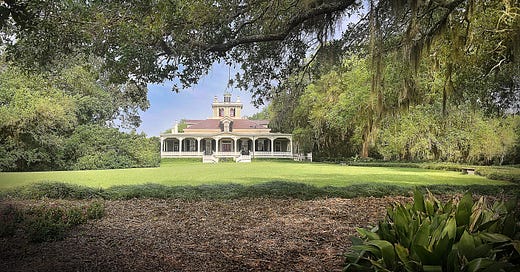Treasured View
Jean Laffite may or may not have buried three metal chests of gold coins and treasure on this site, but it is for certain that someone did, pointing to the fact that long before stage actor Joseph Jefferson built this grand Victorian mansion in 1870 on one of the famed “Five Islands” in south Louisiana, there was drama.
The islands are massive domes of salt surrounded by marsh (hence the term “island”) that sit atop a salt deposit geologists estimate goes deeper into the earth than the height of Mt. Everest. In addition to Jefferson Island, there is also Avery Island (famous home of Tabasco Sauce), Weeks Island, Cote Blanche, and Belle Isle.
Originally known as Orange Island, Jefferson Island was allegedly a favorite hideout of infamous Gulf pirate, Jean Laffite. As one of only a handful of Laffite scholars actively researching the life and times of the pirate today, I use the term “allegedly” on good authority. For every nugget of Laffite truth that my daughter and I have been able to establish, there are also a dozen myths and legends. Take that and extrapolate it across the Gulf Coast a hundred times over, and you end up with a series of tales along the lines of “Laffite slept here” that touches nearly every bayou, marsh, inland port, river, bay and offshore island from Texas to Florida. If all are to be believed, this man got around.
Having said that, a crew foreman named Daynite found something here in 1923 that is anything but a myth. While overseeing the digging of a culvert on the island, Daynite unearthed three metal chests containing gold and silver doubloons. Property owner John Bayless, who had purchased the place from Joseph Jefferson in 1917, got wind of the discovery and was able to wrest at least some of it from the hands of the foreman. That portion is now on display inside this house. Additionally, the location of the discovery was beneath two massive old live oaks which are today known as the Laffite Oaks.
As intriguing as the story is, it does contain holes. A man named Isaac Randolph, who owned this island from 1820 until 1833, was said to be Laffite’s brother-in-law. But there is no record of Laffite having ever been married or having had a sister. What is more, by the time Randolph would have acquired this property in 1820, Laffite had fled Louisiana for the hoped-for safety of Galveston, Texas - a safety that never materialized. The death penalty for anyone caught in the act of piracy was still too close for comfort, even in Galveston, so a couple of years later, Laffite disappeared into the Gulf of Mexico. When he did reemerge in 1830, he was careful to stay far away from his old Louisiana haunts, eventually settling in North Carolina.
That is not to say that he didn’t indulge in a bit of sneaking around. His famous propensity for chameleon-like behavior makes anything possible. And we know for a fact that while his home base remained in North Carolina until his death in 1875, he was gone for extended periods of time. Impossible to say for sure - but perhaps the old pirate did make a return trip to Jefferson Island in search of what he had left behind. If so, he never found it. And even so, the presence of the oaks and the treasure itself makes for a good story to ponder while enjoying this view.
Photo by Beth Yarbrough.




